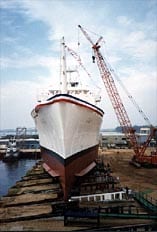U.S. Navy to Launch Ship Named for Woods Hole Oceanographic Institution Scientist
October 17, 2000
It won’t be just another ship launching when the USNS MARY SEARS rolls down the ways at the Halter Marine Shipyard in Pascagoula, Mississippi, October 19. For the first time in its 225-year history, the Navy is naming one of its research vessels for a woman, Mary Sears. A marine biologist, the late Mary Sears was one of the first staff members at Woods Hole Oceanographic Institution (WHOI ) and a guiding force in its development. She remianed on staff for many years and was a Scientist Emeritus at the time of her death in 1997. A WAVE during World War II, she provided intelligence reports predicting the presence of areas of the ocean where submarines could help escape enemy detection.
WHOI Director Robert B. Gagosian will speak at the launch ceremony and a number of WHOI staff will attend the ceremony, including Associate Director for Marine Operations Richard Pittenger, a former Oceanographer of the Navy. Many members of the Sears family will also attend the ceremony.
The ship will be christened by Alice Rivlin, former Vice Chair of the Federal Reserve, and Leila Sears, sister of Mary Sears, who was also a WAVE during World War II. Gary Kinder, author of Ship of Gold, will give the keynote speech.
A Navy WAVE she was sent to Washington DC during World War II to work in the Hydrographic Office. Her intelligence reports, “Submarine Supplements to the Sailing Directions,” predicted the presence of thermoclines, or areas of rapid water temperature change, under which a submarines could hide to escape enemy detection by surface sonar. She established a small oceanographic unit in the Navy’s Hydrographic Office and helped expand the role of applied oceanography within the Navy. After the war, she returned to WHOI and served as a Commander in the US Naval Reserve until 1963.
The USNS MARY SEARS will be the sixth Pathfinder T-AGS 60 class (T-AGS 65) ship built by the Navy. Like all of the Pathfinder class ships, it will be a multi-mission oceanographic survey ship capable of surveying in either coastal or deep ocean waters and always forward deployed – having no stateside homeport. Its dual capability is indicative of the U. S. Navy’s increased emphasis on shallow water or littoral surveying – referring to the water area along the coastline extending inland to where naval influences can still be exerted. The oceanographic data collected by Navy’s oceanographic survey ships are necessary to our military forces operating on, over, and above the seas, who must be prepared to sail in to-and out of-anywhere on the globe at a moment’s notice.
The Pathfinder class ships, each 329 feet long and displacing 4,700 tons, are equipped with the latest survey technology. They are designed and constructed to provide multiple capabilities, including physical, chemical and biological oceanography; multi-discipline environmental investigations; ocean engineering and marine acoustics; marine geology and geophysics; and bathymetric, gravimetric and magnetometric surveying. The sponsor for the ships is the Oceanographer of the Navy on the staff of the Chief of Naval Operations. The surveys are conducted for the Naval Meteorology and Oceanography Command by personnel of the Naval Oceanographic Office. The ship will be operated by the Military Sealift Command. Surveys will be made throughout the world based on needs identified by the Commanders in Chief.


